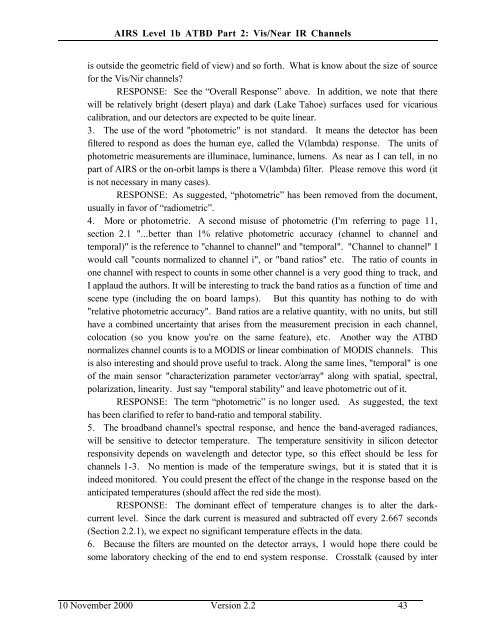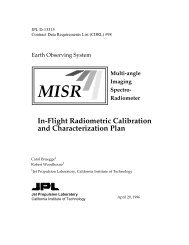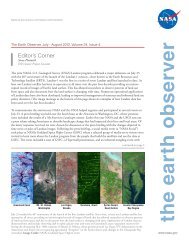AIRS Level 1B Visible/Near-Infrared Channels ATBD - NASA's Earth ...
AIRS Level 1B Visible/Near-Infrared Channels ATBD - NASA's Earth ...
AIRS Level 1B Visible/Near-Infrared Channels ATBD - NASA's Earth ...
Create successful ePaper yourself
Turn your PDF publications into a flip-book with our unique Google optimized e-Paper software.
<strong>AIRS</strong> <strong>Level</strong> 1b <strong>ATBD</strong> Part 2: Vis/<strong>Near</strong> IR <strong>Channels</strong><br />
is outside the geometric field of view) and so forth. What is know about the size of source<br />
for the Vis/Nir channels?<br />
RESPONSE: See the “Overall Response” above. In addition, we note that there<br />
will be relatively bright (desert playa) and dark (Lake Tahoe) surfaces used for vicarious<br />
calibration, and our detectors are expected to be quite linear.<br />
3. The use of the word "photometric" is not standard. It means the detector has been<br />
filtered to respond as does the human eye, called the V(lambda) response. The units of<br />
photometric measurements are illuminace, luminance, lumens. As near as I can tell, in no<br />
part of <strong>AIRS</strong> or the on-orbit lamps is there a V(lambda) filter. Please remove this word (it<br />
is not necessary in many cases).<br />
RESPONSE: As suggested, “photometric” has been removed from the document,<br />
usually in favor of “radiometric”.<br />
4. More or photometric. A second misuse of photometric (I'm referring to page 11,<br />
section 2.1 "...better than 1% relative photometric accuracy (channel to channel and<br />
temporal)" is the reference to "channel to channel" and "temporal". "Channel to channel" I<br />
would call "counts normalized to channel i", or "band ratios" etc. The ratio of counts in<br />
one channel with respect to counts in some other channel is a very good thing to track, and<br />
I applaud the authors. It will be interesting to track the band ratios as a function of time and<br />
scene type (including the on board lamps). But this quantity has nothing to do with<br />
"relative photometric accuracy". Band ratios are a relative quantity, with no units, but still<br />
have a combined uncertainty that arises from the measurement precision in each channel,<br />
colocation (so you know you're on the same feature), etc. Another way the <strong>ATBD</strong><br />
normalizes channel counts is to a MODIS or linear combination of MODIS channels. This<br />
is also interesting and should prove useful to track. Along the same lines, "temporal" is one<br />
of the main sensor "characterization parameter vector/array" along with spatial, spectral,<br />
polarization, linearity. Just say "temporal stability" and leave photometric out of it.<br />
RESPONSE: The term “photometric” is no longer used. As suggested, the text<br />
has been clarified to refer to band-ratio and temporal stability.<br />
5. The broadband channel's spectral response, and hence the band-averaged radiances,<br />
will be sensitive to detector temperature. The temperature sensitivity in silicon detector<br />
responsivity depends on wavelength and detector type, so this effect should be less for<br />
channels 1-3. No mention is made of the temperature swings, but it is stated that it is<br />
indeed monitored. You could present the effect of the change in the response based on the<br />
anticipated temperatures (should affect the red side the most).<br />
RESPONSE: The dominant effect of temperature changes is to alter the darkcurrent<br />
level. Since the dark current is measured and subtracted off every 2.667 seconds<br />
(Section 2.2.1), we expect no significant temperature effects in the data.<br />
6. Because the filters are mounted on the detector arrays, I would hope there could be<br />
some laboratory checking of the end to end system response. Crosstalk (caused by inter<br />
10 November 2000 Version 2.2 43







